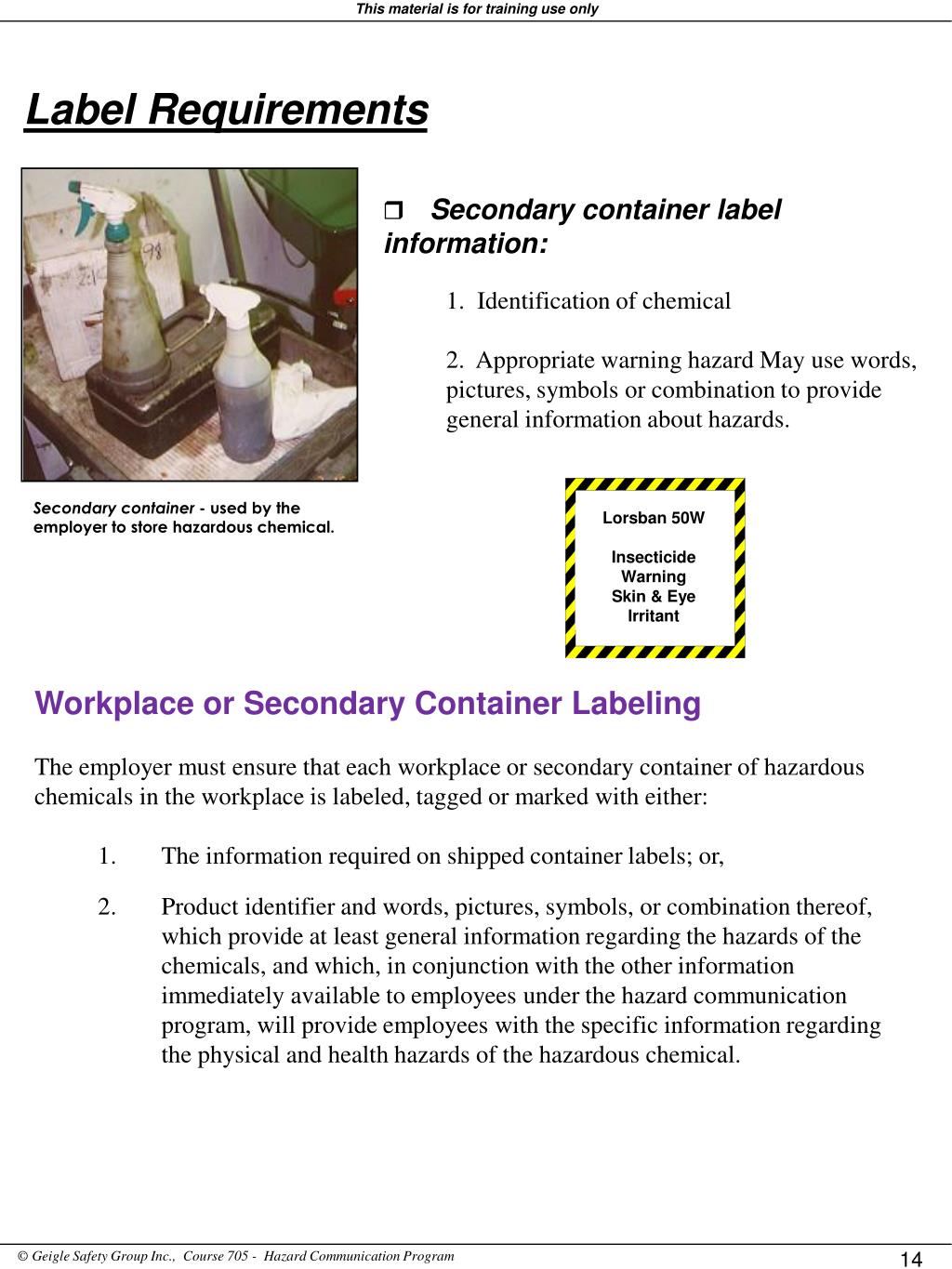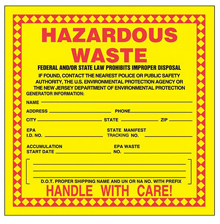44 primary container labels of hazardous chemicals
Chemical Container Labeling - Syracuse University The manufacturer's container label must have specified elements including pictograms, signal words and hazard and precautionary statements which provide hazard information to the end user. The University must ensure manufacturer container labels are maintained in good condition and replaced when needed. What Required Information Must GHS Labels Include? - MPC Secondary containers are typically used by employers that make use of hazardous chemicals and products received from manufacturers. ... Here's a look at each requirement for GHS-compliant primary container labels. Signal word - The signal word, such as "Danger," or "Warning," is used to indicate the hazard level. Danger indicates ...
Labeling requirements of hazardous chemicals. | Occupational Safety and ... The using employer has the responsibility to ensure that each container of hazardous chemical in the workplace is labeled, tagged, or marked with the following information: i) Identity of the hazardous chemical (s); ii) Appropriate hazard warnings.

Primary container labels of hazardous chemicals
Proper Labeling Chemical Containers - Hazcom ... - OSHA Review The chemical manufacturer must ensure that primary label is marked with the following information: Product identifier - The name or number used for a hazardous chemical on a label or in the safety data sheet (SDS). Signal word - A word used to indicate the relative level of severity of hazard and alert the user to a potential hazard. PDF Hazard Communication Standard Labels - Occupational Safety and Health ... All labels are required to have pictograms, a signal word, hazard and precautionary statements, the product identifier, and supplier identification. A sample revised HCS label, identifying the required label elements, is shown on the right. Supplemental information can also be provided on the label as needed. Hazard Communication Standard Labels OSHA: Container Labels Flashcards | Quizlet Secondary containers, which are also called workplace containers, are usually smaller, more manageable containers that a chemical is transferred to for easier handling. If a worker transfers a chemical into a secondary container, when must a label be used? ... An entirely separate set of pictograms is used for the transport of hazardous ...
Primary container labels of hazardous chemicals. Hazard Communication - Container Labeling - OSHAcademy free online training The HCS 2012 primary container label on the right provides an immediate visual reminder of the hazards of a chemical. However, it isn't necessary to list every hazard of the chemical on the label. ... The employer must ensure that each secondary container of hazardous chemicals in the workplace is labeled, tagged or marked with either: What is the Difference between Primary and Secondary Chemical Containers? Both primary and secondary containers must be labeled. According to 1910.1200 (f) (7), however, the employer is not required to label portable containers into which hazardous chemicals are transferred from labeled containers, and which are intended only for the immediate use of the employee who performs the transfer. GHS Labeling Requirements: The Definitive Guide [2021 Update ... - Luminer However, the GHS takes into consideration that, sometimes, it's not possible to keep workers safe with only these six label requirements, which is why it also allows for supplemental information. 1. Product Identifier. This requirement identifies the actual hazardous chemical inside the container. OSHA Hazard Communication and Chemical Hygiene for Healthcare Personnel ... A hospital laundry department labels its secondary containers of hazardous chemicals with a color-coded system, with a different color representing each different type of hazard. The coding system follows the color-coding used by the National Fire Protection Agency's "fire diamond."
Container Labeling and Other Forms of Warning - Virginia Tech Container Labeling and Other Forms of Warning. The HazCom Coordinator or designee shall ensure primary and secondary hazardous chemical containers are properly labeled. All labels and warnings should be legible, written in English and prominently displayed on the container. Chemical manufacturers, importers, or distributors are required by OSHA ... PDF Mystery containers — Labels matter the classification and labeling of chemicals, and can provide guidelines. ... GHS requires that: • It must be labeled with all the original hazard information from the primary container. • Or, it must contain a general label with the appropriate pictogram, hazardous property, and name of the chemical. For example, a secondary container of ... Secondary Containers | Environmental Health, Safety and Emergency ... OSHA says you have to put the PRODUCT NAME, the HAZARDOUS CHEMICALS it contains, and words or pictures that show the KEY HAZARDS (e.g. inhalation hazard, ingestion hazard, skin absorption hazard, skin irritant, eye corrosion hazard, etc). This information can be found on the chemical's original container, or on the MSDS. 4 Quick Tips to Help You Ace OSHA Secondary Container Labeling The original container in which a chemical arrives from the supplier is considered the primary container. The primary container label for a hazardous chemical should always be an OSHA-compliant GHS chemical label and contain all information needed to create a compliant secondary container label. Secondary Container Definition
Hazard Communication Chemical Labeling - Shepherd University Primary container labels on hazardous chemicals and products provided by manufactures and suppliers are required to have six elements. The six elements are pictograms (see below), a signal word ("Danger" or "Warning"), hazard and precautionary statements, the product identifier (product/chemical name), and supplier information. Secondary Container Label Requirements | HCL Labels Primary containers come straight from the manufacturer. They come in drums, tubs, pails, bottles, or other larger canisters that are pre-labeled with the chemical identifier. The "primary container" labels are required to include the manufacturer information. The next section is where things are a little confusing. Labeling Laboratory Containers | Columbia | Research All laboratory containers, even those containing minimally hazardous materials such as water or buffer solutions, must be labeled. Writing the name of the material on the container is perfectly acceptable, but if you are interested in a more permanent solution, please consider the following labeling tools that EH&S has put together. Container Labeling: A Key to Compliance - Occupational Health & Safety Containers also must have the following identification on the container, label or tag [29 CFR 1910.1200 (f) (1)]: The identity of the hazardous chemical. Appropriate hazard warnings. The name and ...
Container Labeling | Office of Environmental Health and Safety | ECU Containers holding non-hazardous substances such as water must also be labeled to avoid confusion with other clear and colorless chemicals. It is acceptable to label these containers "Non-Hazardous". Safety label templates are available to you (will be linked). It is not required that you use these specific labels. Resources
Chemical Hazardous Waste Containers: EPA and DOT Labeling Requirements A container used for chemical hazmat onsite storage must be marked with the words "Hazardous Waste." It must also exhibit the starting date for its accumulation along with information about its contents (e.g., toxic, reactive, ignitable, or corrosive). If you're reusing a container, make sure to remove the old labels.
Reference Guide to GHS Container Labels - UArizona Research, Innovation ... There are six required sections of a GHS-compliant chemical container label: Product Identifiers GHS Pictograms Signal Words Hazard Statements Precautionary Statements Supplier Identification 1. Product Identifiers The product identifier is most often the common product name of the chemical, and must match the product identifier on the SDS.
Types of Containers and Labels - Occupational Health and Safety Blog Under the new HCS 2012, labels on containers shipped from manufacturers or distributors must be labeled, tagged or marked with the following six items: 1. Product Identifier - This should include the chemical identity of the substance. 2. Signal Word ‐ Signal words used in GHS are "Danger" and "Warning."

Custom Permanent Adhesive Chemical Container Outside Warning Label For Hazards - Buy Container ...
Chemical Container Labeling - Northwest Safety Chemical Container Labeling The Hazard Communication Standard (HCS) describes chemical labels as information provided through a group of written, printed, or graphic appropriate elements concerning a hazardous chemical. These should be that placed on the immediate container of a hazardous chemical.
PDF HEALTH & SAFETY Chemical Container Labeling Although OSHA regulations require labeling only those containers with hazardous chemicals, EH&S recommends all non-hazardous chemical containers be labeled with the product identity in order to minimize confusion. In the event there is a chemical with no OSHA hazard, then a label will make that fact obvious.
Chemical labels | Environmental Health & Safety - Michigan State University Container Labels. All containers of hazardous chemicals must be labeled with the name of the chemical and the hazard (s), if not provided by the manufacturer. If a chemical has more than one hazard, it must be labeled with both hazards. For example, acetaldehyde is both a flammable and a carcinogen, and must be labeled appropriately.
Chemical Container Label Requirement | EMC - EMC Insurance Each label must contain the following information: Identity of the material Signal word Hazard statement (s) Pictogram (s) Precautionary physical and health hazards associated with the material Name and address of the chemical manufacturer, importer or other responsible party
Chemical Container Labels | EHS - University of Washington All hazardous chemical waste mus t be labeled with the UW label shown unless the material is still in its original manufacturer's container. Containers need to be labeled as soon as waste begins to be accumulated in them. Hazardous waste labels are available on the EH&S website.
Rules for Proper Secondary Container Labeling - HSI Secondary Container Label Requirements. Employers must make sure that each container of hazardous chemicals in the workplace is labeled, tagged, or marked with either of the following: All the information specified for the labels on shipped containers. The hazard identification and words, pictures, symbols, or a combination that provide at ...
OSHA: Container Labels Flashcards | Quizlet Secondary containers, which are also called workplace containers, are usually smaller, more manageable containers that a chemical is transferred to for easier handling. If a worker transfers a chemical into a secondary container, when must a label be used? ... An entirely separate set of pictograms is used for the transport of hazardous ...
PDF Hazard Communication Standard Labels - Occupational Safety and Health ... All labels are required to have pictograms, a signal word, hazard and precautionary statements, the product identifier, and supplier identification. A sample revised HCS label, identifying the required label elements, is shown on the right. Supplemental information can also be provided on the label as needed. Hazard Communication Standard Labels
Proper Labeling Chemical Containers - Hazcom ... - OSHA Review The chemical manufacturer must ensure that primary label is marked with the following information: Product identifier - The name or number used for a hazardous chemical on a label or in the safety data sheet (SDS). Signal word - A word used to indicate the relative level of severity of hazard and alert the user to a potential hazard.












Post a Comment for "44 primary container labels of hazardous chemicals"